Abstract
Photovoltaic (PV) systems have been growing in popularity as an energy conservation and carbon reduction approach. Generally, battery storage is integrated with a PV system to solve the intermittent and fluctuant problems of solar resources, enhancing the relative independence of the PV–battery (PVB) system. In consideration of the economic benefits and system efficiency, it is necessary to investigate battery capacity allocation methods. A battery capacity configuration method was established in this study to increase the self-sufficiency rate (SSR) and self-consumption rate (SCR) of the system for a building complex by exploiting the battery resources. The PVB system designed for the building complex is divided into two categories: distributed and centralized storage. The SSR and SCR significantly increase with the increasing battery capacity for both schemes. The SCR of centralized storage is always higher than that of distributed storage, considering different battery and PV capacities. However, the SSR of distributed storage scheme was found to be slightly higher than that of the centralized storage scheme when the energy generated by PV is half of the energy consumed by the building load. For instance, when the battery capacity is four, SSR values for optimal distributed and centralized storage schemes are 47.62% and 47.19%, respectively. For the distributed storage scheme, there is a slight difference between the optimal allocation ratios achieved by SSR and SCR, considering that they have the same total battery capacity. In addition, the effects of converter loss, complementarity in load curves, and centralized batteries were analyzed to achieve greater SSR and SCR. The comparison results of this study can be used as a guide for battery capacity design in the PVB systems of building complexes.
1. Introduction
Recently, energy demand and carbon emissions have rapidly grown worldwide [1,2]. Building operations consume nearly 40% of the energy and generate approximately 30% of the total carbon emissions [3,4]. Renewable energy sources, which are sustainable, abundant, and convenient to use, are thought to be an alternative to traditional fuels [5]. Therefore, it is encouraged to take full advantage of clean, renewable energy sources. Solar power generation, wind power generation, and solar heat collection are common techniques [6]. The contribution of solar and wind energy to power generation is increasing and studies related to 100% renewable energy scenarios indicate that the contribution of solar PV may be more than 50% by 2050 [7]. The installed PV capacity in China increased from 0.03 GWh in 2009 to 204.18 GWh in 2019 [8].
Much attention has been paid to the distributed photovoltaic (PV) systems applied in buildings. By 2019, the U.S. had 70 GWDC of solar capacity and the National Renewable Energy Laboratory found that the technical solar potential of suitable residential buildings was over 700 GWDC [9]. Gul et al. [10] proposed a grid-connected PV system for a university campus and neighboring communities. The system exhibited excellent performance in terms of flexibility, reliability, climate resilience, and carbon emission reduction. Gerber et al. [11] analyzed the efficiency of photovoltaics integrated with a DC power network in commercial buildings. The results indicated that buildings with large PV and battery capacities achieved efficiency savings of more than 11%. Ge et al. [12] investigated the matching characteristic of a rooftop hybrid photovoltaic–wind system and building energy consumption. The proposed general method for analyzing rooftop hybrid systems can enable widespread and efficient solar and wind energy utilization in densely populated urban areas. Zhang et al. [13] proposed a controller that achieved 12% annual electricity cost savings and 34% peak demand reduction for PV systems in commercial buildings compared with the baseline.
However, PV power generation fluctuates [14] and is intermittent [15] because of the solar source, which causes unstable and volatile electricity output to the grid [16,17]. Consequently, problems such as the curtailment of PV generation and difficulties in grid connection need to be urgently solved [18]. Configuration of the energy storage system is considered an effective way to solve these problems [19,20]. Generally, the chemical battery is chosen as the energy storage method, because of its characteristics of high energy density, long lifetime [21], and great performance in circulating operation [22]. Khezri et al. [23] evaluated the optimal sizing and economic analysis of a rooftop PV and battery energy storage system for grid-connected households. This study found that the PV–battery (PVB) system is more economical for all-electric houses. Argyrou et al. [24] proposed a novel power management strategy for a residential-grid-connected PV system with battery-supercapacitor storage to increase self-consumption and self-sufficiency. The system achieved effective power sharing among the PV, battery-supercapacitor storage, building load, and grid.
Despite the advantages of battery storage, its high cost [25] has been a significant obstacle in the deployment of chemical batteries in PV systems. It is necessary to investigate battery capacity allocation problems to achieve high system performance and economic benefits. Li et al. [26] developed a capacity optimization configuration method for a photovoltaic and energy storage hybrid system considering its entire life cycle. With the proposed capacity allocation method, the economic efficiency of the system was significantly improved while ensuring demand for the supply load. Zou et al. [27] discussed three groups of factors of uncertainty relating to outdoor conditions, building construction, and indoor conditions, in PV and battery capacity design. Capacity configuration indices were proposed to achieve the required self-sufficiency rate (SSR) and self-consumption rate (SCR) for office buildings in hot summer and cold winter areas. Li et al. [28] investigated the battery capacity that should be deployed to achieve a high load cover ratio of a grid-connected PVB system in gymnasium buildings. Mohamad et al. [29] optimized the battery capacity allocation for a PV power station and decreased the curtailment of the PV generation. Anuradha et al. [30] analyzed the effect of battery allocation on network loss and voltage variations in a distributed PV generation system with the goal of applicable power dispatch. Dawei et al. [31] proposed a novel battery capacity optimization configuration method that considers the rate characteristics in primary frequency regulation to enhance the power system frequency regulation capability and performance.
Most existing studies based on battery storage allocation in the PVB system have focused on the rooftop PV system of standalone buildings and large-scale PV power stations, even the integrated grid, aimed at price arbitrage, minimizing costs, improving grid frequency regulation, and improving power quality. Few studies have focused on the battery capacity configuration of building complexes comprising different types of buildings. The mismatch characteristics of the building load and PV generation for each building are diverse, which causes different battery capacities to be equipped in various buildings. When considering the building as a complex, both the power network topology and battery capacity allocation ratio influence the system performance. In this study, the appropriate battery configuration size and arrangement location were analyzed according to the SSR and SCR. This study attempted to reveal the differences between a single building and a building complex in the battery size design phase. The main conclusions and contributions of this study are as follows:
- (1)
- A distributed storage scheme and centralized storage scheme of a building complex are proposed in this paper. The strengths of each scheme are compared based on the evaluation indicators.
- (2)
- The optimal allocation ratio of battery capacity with a distributed storage scheme is applied to the building complex.
- (3)
- A battery having a suitable size should be equipped to achieve high SSR and SCR for the centralized distributed scheme under different PV penetrations.
- (4)
- Evaluation criteria between SSR and SCR are selected while determining the battery configuration size of a building complex.
The remainder of this paper is organized as follows. In Section 2, the system layout and model of the components of the PVB system are presented. The evaluation indicators and operational strategy of the system are introduced. In Section 3, the process results of a single building, distributed storage scheme, and centralized storage are compared according to SSR and SCR. The effects of battery loss and converter loss on the indicators of the system are discussed in Section 4. In addition, the performance of the PVB system is analyzed for different PV penetrations. Finally, the relevant conclusions are presented in Section 5.
2. Materials and Methods
2.1. System Layout
Figure 1 shows the schematic design of the grid-connected PVB system for a single building, which comprises PV modules, battery, building loads, utility grid, DC/DC converters, and a bidirectional AC/DC inverter. The energy generated by the PV modules is supplied to the building load and battery, and it is exported to the utility grid when the PV electricity has a surplus. During PV shortage conditions, the battery is discharged and some energy is imported from the utility grid to guarantee electricity provision of the PVB system. The grid-connected PVB system for a building complex, composed of offices, apartments, and mall buildings, is displayed in Figure 2. All buildings are linked to a high-level DC bus using standalone DC/DC converters, and the energy exchange between the building complex and utility grid is achieved using a unified AC/DC inverter. Compared with the PVB system of a single building, there is an additional energy conversion process for building complexes considering a standalone DC/DC converter efficiency of 0.98. The configuration can be classified into two categories based on battery placement position. For the distributed storage scheme, the battery is linked to the DC bus of the building and provides service only for its buildings. In the centralized storage scheme, there are no battery banks in the building interior, and the battery is entirely arranged in the high-level DC bus, which is responsible for all buildings.
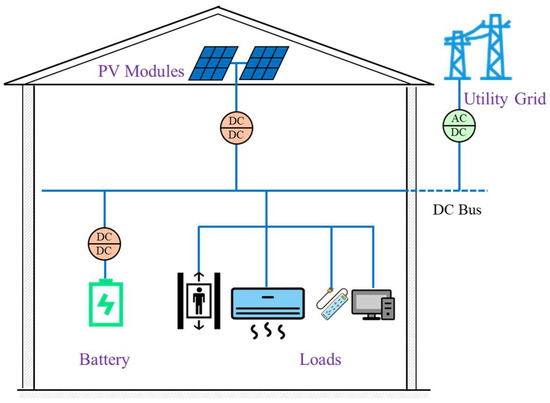
Figure 1.
Topology of the grid-connected PVB system for a single building.
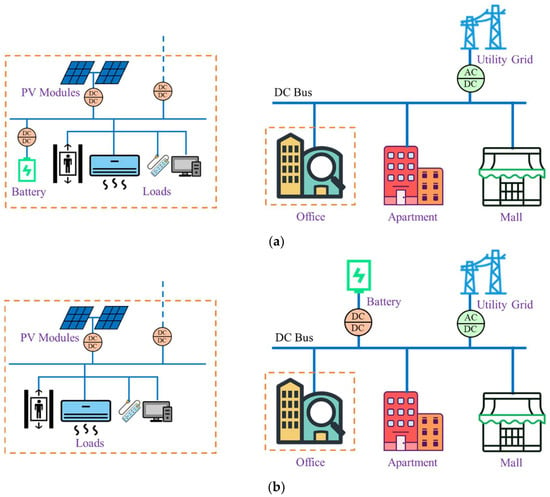
Figure 2.
Topology of the grid-connected PVB system for a building complex: (a) distributed storage; (b) centralized storage.
Raw annual building load data were obtained from operating offices, apartments, and mall buildings in Beijing, China. For the convenience of load calculation and comparison, the load power time series of the three buildings were scaled to the same average daily electricity consumption of 100 kWh per day. In addition, the proportioned load profile was directly used as input power data during the simulation process. The detailed time series load data are illustrated in Appendix A.
2.2. System Model
2.2.1. PV Generation
The generation power of the PV system is determined as [32]:
where PPV indicates the actual generation power of the PV modules, PPV,rated indicates the rated PV generation power, It denotes the solar radiation intensity incident on the PV panels (W/m2), γ symbolizes the temperature power coefficient (0.0045/°C), TPV and Ta denote the temperatures of PV cells and ambient air, respectively, and NOCT indicates the nominal operating cell temperature (45 °C) [32].
The solar radiation intensity on the plane of the PV panels is calculated as [27]:
where Idir, Idif, and I denote the direct solar radiation intensity, diffuse solar radiation intensity, and global solar radiation intensity on the horizontal plane (W/m2), Rdir denotes the ratio of direct solar radiation on the inclined plane to the horizontal plane, ρ indicates the reflectance coefficient of the ground (0.2), and β corresponds to the installation angle of the PV panels (β = 30° is adopted in this study).
2.2.2. Battery System Model
The state of charge (SOC) is defined as the ratio of the energy content of the battery (Eb) to the rated battery capacity (Capb) in Equation (4). The operational conditions of the battery can be divided into charging and discharging processes as shown in Equation (5):
where Pb denotes the actual operating power of the battery; Pb,ch and Pb,dis represent the charging power and discharging power of the battery, respectively; and α corresponds to a binary number, where 1 represents the battery charging process and 0 represents the battery discharging process.
The SOC is limited by the maximum and minimum states of energy (SOCmax and SOCmin) as shown in Equation (6). More specifically, Pb is limited by the maximum charging power () and maximum discharging power () to prevent over charging and over discharging, as shown in Equation (7):
During the discrete simulation process, SOC at each time step was calculated using Equation (8) [33]:
where ηch and ηdis denote the charging and discharging efficiencies of the battery, respectively; Δt symbolizes the time increment, and the time step is taken as 1/10 h in this study.
2.3. Evaluation Indicators
SSR and SCR were chosen as evaluation indicators of the PVB system in this study. SSR is the proportion of the total load consumption supplied by the PV-generated electricity. SCR is the proportion of the total PV generation consumed by the PVB system. Collectively, SSR and SCR denote the relative independence of the PVB system and utility grid, aimed at the supply and demand sides, respectively. SSR and SCR are defined in Equations (9) and (10), respectively:
where Eload denotes the total electricity consumption of the building load (kWh), Eg,im indicates the electricity imported from the utility grid (kWh), EPV symbolizes the total electricity generated by the PV modules (kWh), and Eg,ex indicates the electricity exported to the utility grid (kWh).
2.4. System Operation Strategy
For PVB systems, maximizing the SSR and SCR is usually the ultimate control goal, with the battery having the flexibility to charge and discharge. The system operation strategy is illustrated in Figure 3. For a single building, the battery is charged first when the PV generation has a surplus of energy, and is discharged when the PV generation is less than the building load. The power of the battery is limited by the operational range of the SOC and maximum charging/discharging rate of the battery, as expressed in Equations (6) and (7). The power of the utility grid, building load, PV, and battery should maintain energy balance. Consequently, the power of the utility grid is calculated using the algebraic sum of the others. When distributed storage is adopted in the building complex, the battery control method for each building remains the same, except for the final exchange of power with the grid (Pg), which is calculated as the sum of for each building, as determined by the system topology shown in Figure 2. For centralized storage, there is no battery inside the building, and the building achieves an electricity exchange with the DC bus. Hence, the unified battery will respond following the complementation of each building. For example, when the PV generation is larger than the office building load and the PV generation of the apartment cannot cover the building load, the battery is probably not charged or discharged because of the demand and supply offset in the two buildings. The operating state of the battery is determined by the total energy requirement of the buildings and the battery safety management limit, as shown in Figure 3.
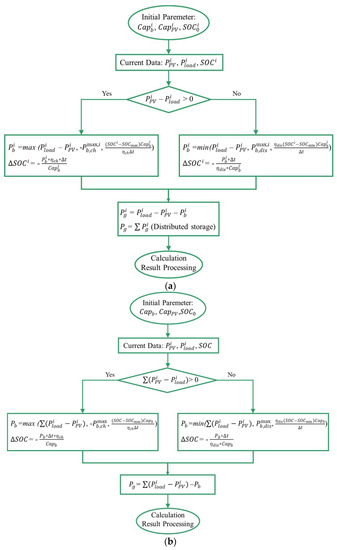
Figure 3.
Flow chart of the system strategy (the superscript i represents office, apartment, and mall): (a) single building and distributed storage (the power of utility grid is the algebraic sum of for three buildings); (b) centralized storage.
3. Results
The total PV energy generation during the entire year is the same as the annual building load for offices, apartments, and malls. For the convenience of comparison of battery capacity for different buildings, the battery is nondimensionalized by a multiple of the average daily building load (100 kWh). The detailed specifications of the battery bank used in this study are listed in Table 1 [18].

Table 1.
Specification of the battery used in this study.
3.1. Single Building
The effect of battery capacity in a single building on SSR and SCR is discussed in this section. The results are illustrated in Figure 4. For each type of building, both SSR and SCR significantly increase with the increasing battery capacity. The increasing trend slows when the battery capacity is relatively high. This indicates that a greater Capb can increase the independence of the PVB system in terms of both self-sufficiency and self-consumption. With the same battery capacity, the SSR and SCR of the apartment are the lowest compared to those of the office and mall. When Capb is lower than 0.8, the SSR and SCR of the mall are higher than those of the office. When the Capb is greater than 0.8, the SSR and SCR of the mall are lower than those of the office, and the difference gradually increases with an increase in Capb. For example, when Capb is equal to 0.2, SSR values for office, apartment, and mall are 0.62, 0.48, and 0.63, respectively. When Capb is equal to 2.0, SSR values for office, apartment, and mall are 0.82, 0.78, and 0.81, respectively. Table 2 lists the detailed battery capacities for each building under specific SSR and SCR values, which will be used as basic input data in the calculation in a later section.

Figure 4.
Evaluation indicators of the single building for different battery capacities: (a) SSR; (b) SCR.

Table 2.
Battery capacities for every single building under specific SSR and SCR values.
3.2. Building Complex
3.2.1. Distributed Storage
In this section, the battery is placed inside the building and is not shared with others, as shown in the topology in Figure 2a. This implies that the battery allocated to each building will only absorb the surplus PV power generated inside the building and cover its load. However, the building complex is identified as a whole when calculating the evaluation indicators. The effect of the proportion of battery capacity allocated among these buildings on the relative independence of the building complex with a certain total battery capacity is analyzed and not limited to a single building.
The battery capacity for each building is arranged according to the calculation results listed in Table 2 as the basic case, and the PVB system used the same evaluation indicators for the single building scheme. Figure 5 shows the concrete allocation capacity for each scenario and the corresponding SSR and SCR results. As shown in Figure 5, the gray dashed line represents the reference indicators of the original single-building scheme. SSR of the basic case is less than the reference value, and the difference gradually decreases with an increase in battery volume. SCR of the basic case is greater than the reference value, and the difference gradually decreases with an increase in battery volume. As shown in Figure 1 and Figure 2a, there is an additional DC/DC converter for each building in the distributed storage scheme for the building complex. The extra energy loss produced in this DC/DC converter requires the added electricity to be imported from the utility grid and the reduced electricity to be exported to the utility grid. Consequently, the SSR of the distributed scheme is lower than the reference value of the single building, and the SCR of the distributed scheme is higher than the reference value of the single building. The impact of the increased battery capacity can be explained by the fact that energy exchange is more likely to finish inside the building, and less energy is exchanged with the DC bus through the DC/DC. Therefore, the influence of the DC/DC loss weakens.

Figure 5.
Results for the basic case with the same battery allocation determined by single building: (a) SSR; (b) SCR.
As mentioned above, the battery capacity allocated to each building influences the final SSR and SCR of the building complex. The optimal allocation to achieve the maximum SSR and SCR is discussed. The calculation patterns for all the allocation proportions are shown in Figure 6. The white marks correspond to the maximal SSR and SCR and the corresponding allocation ratio. For instance, when SSR reaches a maximum of 69.9%, the capacity allocated for office, apartment, and mall is 0.413, 0.609, and 0.378, respectively. SCR reaches a maximum of 73.7% when the capacity allocated for the office, apartment, and mall is 0.413, 0.609, and 0.378, respectively. Using the optimization method shown in Figure 6, the optimal allocation proportion and maximum indicators under different battery capacities are acquired. As shown in Figure 7, the SSR and SCR of the building complex increase with an increase in total battery capacity. The battery is mainly dispatched to the apartment, particularly in the relatively low Capb situation, and the proportions for the office and mall are almost the same. This is determined by the characteristics of the relative independence of the PVB system in a single building, as discussed in Section 3.1. SSR and SCR of the apartment are the lowest of the three buildings, and SSR and SCR for the office and mall have almost no difference. Moreover, the allocation ratio comparison between Figure 7a and Figure 7b indicates that the optimization directions of SSR and SCR are coincident, which means that the PVB system in a distributed storage scheme usually achieves a high SCR when the SSR of the system is high.
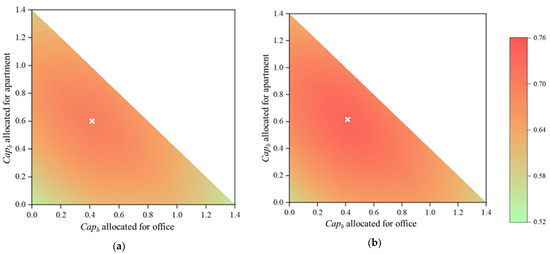
Figure 6.
Optimal allocation processing pattern when Capb takes 1.4: (a) SSR, (b) SCR.

Figure 7.
Allocation proportion and maximum indicators under different battery capacities: (a) SSR; (b) SCR.
3.2.2. Centralized Storage
The building complex adopts a centralized storage scheme with the topology shown in Figure 2b. There is only one battery location for the system, and Figure 8 analyzes the effect of Capb on the two indicators. The green points indicate the results for the total capacity listed in Table 2. SSR and SCR of the building complex increase with total battery capacity.
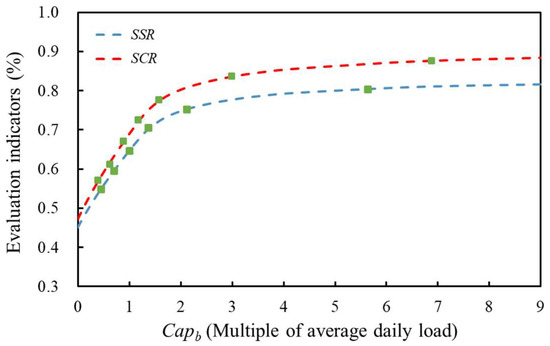
Figure 8.
Calculation results of the centralized storage scheme for different battery capacities.
3.3. Comparison of Different Configuration Way
Figure 9 presents the comparison results of different battery arrangement schemes with the same total battery capacity aimed at different contrastive indicators. It can be observed from the title of the horizontal axis that the total battery capacity is chosen as the result in Table 2. For both SSR and SCR, the calculation results of centralized storage are maximal, and the results of the optimal allocation case are higher than those of the basic case. The SSR and SCR values of the horizontal axis are the results of a single building as a reference value. When Capb is 0.444, the SSR is lower than the reference value, which is caused by the energy loss of the converter. The difference gradually turns from negative to positive as Capb increases, which demonstrates the regulating effect of the battery. For SCR, the indicators of the three schemes are all higher than the reference SCR. Moreover, the difference between the optimal allocation case and reference SCR value decreases with an increase in Capb but gets larger for the centralized scheme and reference SCR value. This is mainly because a centralized battery can be utilized more adequately. In summary, the results imply that the centralized storage scheme is better for achieving the maximal SSR and SCR. The advantage of the centralized storage scheme increases with higher battery capacity.

Figure 9.
Comparison of different battery arrangement schemes: (a) SSR; (b) SCR.
4. Discussions
4.1. Energy Loss
The energy loss of the PVB system comprises battery loss and converter loss. Battery loss is generated during the charging and discharging processes as determined by ηch and ηdis. The converter plays a crucial role in the electricity transfer part of the PVB system. In particular, for a building complex, the DC/DC converter is responsible for linking the building itself and the entire DC system. Electricity losses occur in power electronic devices during the energy conversion process. This means that the greater the interaction between the building and high-level DC bus, the greater the converter loss.
Figure 10 shows the energy loss of the battery and converter corresponding to the case shown in Figure 9. The converter loss of the building complex is obvious compared to that of a single building. The converter loss of the basic case and optimal allocation decreases with an increase in Capb and the converter loss of centralized storage remains constant, as determined by the system control strategy depicted in Figure 3. The converter losses of the basic case and the optimal allocation are both lower than those of centralized storage. Converter loss requires more energy to be imported from the utility grid and less energy to be exported to the utility grid. Therefore, converter loss causes a decreased SSR and an increased SCR. The battery losses of these four scenarios are close in value, and the loss increases with an increase in Capb. A larger battery loss means that the battery is used more adequately and more energy is transported by the battery. Hence, as explained in Section 3.1, the effect of the battery will increase SSR and SCR, which will increase with an increase in battery capacity. As mentioned above, it is comprehensible that the SSR of the building complex is first lower than the reference, and the higher than the reference later; the SCR of the building complex is consistently higher than the reference, with the interaction of converter loss and battery. The total energy loss of centralized storage is the largest among the four scenarios, which proves that the SCR of centralized storage is maximal. However, this seems to conflict with the maximal SSR value of the centralized storage. This complementarity in the net electricity consumption curve of the three buildings improves the self-sufficiency of the system. The influence of complementarity is hidden by converter loss.
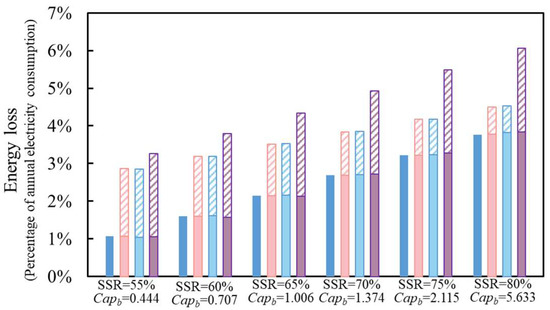
Figure 10.
Analysis of energy loss under the same total battery capacities.
To explore the positive effect hidden by converter loss, the calculation results without considering converter loss are listed in Table 3 and Table 4. The battery capacity of the system is arranged according to the results in Table 2 and matched with the relevant indicators. The SSR of distributed storage is higher than the corresponding reference value, and the SSR of centralized storage is higher than the SSR of distributed storage. This illustrates the effect of complementarity on net load curves. The electricity required from the utility grid may decrease under the condition that energy is surplus for one building but deficient for another, which shows a complementarity process without considering converter loss. For the distributed storage scheme, the net load curve of each building becomes smoother with a higher battery capacity, and the complementarity effect consequently weakens. Therefore, the difference between the SSR of the distributed storage and the reference value decreases with increasing battery capacity. For the centralized storage scheme, the net load curves of the three buildings are fixed, and the complementarity effect between the curves is constant. The difference between the SSR of distributed and centralized storage presents an upward trend with increasing battery capacity. It is reasonable that the SSR of the building complex can be higher than that of a single building, regardless of the battery capacity, battery distribution pattern, and converter loss, with a powerful complementarity effect. The results of SCR exhibit a variation pattern that is similar to that of SSR. The SCR of the distributed storage is higher than the corresponding reference value, and the difference decreases with increasing battery capacity. The SCR of centralized storage is higher than that of distributed storage and increases with the battery capacity. Moreover, it is apparent that SSR increases and SCR decreases without considering converter loss when comparing the result in Figure 9 and Table 3 and Table 4.

Table 3.
SSR comparison between distributed storage and centralized storage without considering converter loss.

Table 4.
SCR comparison between distributed storage and centralized storage without considering converter loss.
In summary, the existence of converter loss will reduce the SSR and increase the SCR of the system; the complementarity effect of load curves will increase both SSR and SCR; and the centralized storage scheme exhibits greater performance than distributed storage, regardless of whether the converter loss is considered.
4.2. Effect of PV Penetration
PV penetration is typically defined as the ratio of the total PV generation energy to the building load. The results in Section 3 are primarily aimed at the condition that the PV penetration value is 1. In this section, the effect of PV penetration on the building complex is analyzed. Table 5 lists the calculation indicators for different PV penetrations. When the PV penetration value is 1 or 1.5, the SSR of the centralized storage is higher than that of the optimal allocation scheme. When the PV penetration is 0.5, the SSR of the centralized storage is lower than that of the optimal allocation scheme, and the SCR for both distribution schemes is almost 100%. It indicates that for the PV penetration condition of 0.5, the major PV generation is directly consumed by the building load, and it is appropriate to store the remaining energy in the battery inside the building, not in the centralized battery storage, which will cause extra energy loss with the converter. The SCR of the centralized storage is always higher than the optimal allocation scheme for each PV penetration, with the influence of the complementarity effect and converter loss. In summary, centralized storage shows better performance than distributed storage, except for some low PV penetration conditions.

Table 5.
Evaluation indicators comparison of optimal allocation and centralized storage under different PV penetration and battery capacity SSR and SCR values.
Table 6 lists the allocation ratios of the three buildings aimed at different optimization goals. When Capb is constant, the allocation ratio varies with PV penetration, and the variation does not show a distinct regularity. Hence, it is essential to consider the PV penetration and characteristics of the building load when selecting an appropriate allocation ratio in practical applications. In addition, the allocation ratio of the SSR optimization process is almost the same as the final allocation ratio for pursuing the maximal SCR under different PV penetrations and battery capacities. As mentioned in Section 3.2.1, the optimization directions of SSR and SCR are coincident in the distributed storage scheme.

Table 6.
Allocation ratio for different optimization goals.
Figure 11 shows the SSR and SCR of centralized storage under different PV penetrations and battery capacities. When the PV penetration is constant, the SSR and SCR both increase with an increase in Capb. When Capb is constant, SSR increases with increasing PV penetration, and SCR decreases with increasing PV penetration. A contour line of 90% is shown in the figure. As shown in Figure 11, it is feasible to achieve a high SSR when the PV penetration is relatively high and achieve a high SCR when PV penetration is relatively low for the centralized storage system. Hence, the configuration goal of the battery capacity can be determined based on the practical capacity of the PV installation. SSR should be recognized as an indicator of high PV penetration conditions, and SCR should be recognized as an indicator of low PV penetration conditions.
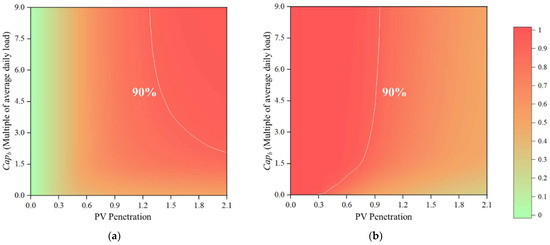
Figure 11.
Effect of PV penetration and battery capacity for evaluation indicators with the centralized storage scheme: (a) SSR: (b) SCR.
4.3. Limitation and Outlook
The results presented in this study are subject to some limitations. The analysis of this study is based on the actual load data investigated from three kinds of buildings in Beijing, China. For the convenience of comparison, the load power time series of the three buildings are scaled to the same average daily electricity consumption of 100 kWh per day, which is different from the real energy consumption proportion. However, the nondimensionalization of load profiles, PV generation, and battery capacity make the simulation results universal. The performance of the PVB system in different PV installations is analyzed as an attempt to present the different relative sizes of PV capacity and building load. Furthermore, the battery capacity configuration method of the PVB system applied in a building complex proposed in this paper and the main conclusion are not limited by whether or not the actual load profile is adopted. The results and methodology relating to capacity configuration with the PVB system can be applied to large-scale building syntheses and used as a guide for battery capacity design in the PVB systems of building complexes. The efficiency of DC/DC in this study is adopted with the current device level. In the future, more efficient DC/DC will be manufactured and the energy conversion loss will be reduced in the PVB systems. However, the effects of converter loss and building load curve complementarity for building complexes are constant.
5. Conclusions
Battery storage is recognized as a powerful technique for enhancing the relative independence between a building PV system and utility grid. This paper presents a battery capacity configuration method for PVBs, aimed at improving the self-sufficiency and self-consumption of building complexes. In addition, the effects of converter loss and building load curve complementarity were analyzed. The main conclusions are as follows:
- (1)
- The centralized storage scheme usually shows a greater system performance than a distributed storage scheme. The technical indicator SSR is more sensitive to the PV capacity than SCR. The SCR of centralized storage is consistently higher than that of distributed storage for different battery capacities and PV penetrations. The SSR of centralized storage is only lower than that of distributed storage in the low PV penetration conditions when the converter loss dominates the benefits of centralized storage.
- (2)
- There is a slight difference between the optimal allocation ratios achieved by the SSR and SCR considering that they have the same total battery capacity when equipped with a distributed storage scheme. The optimal allocation ratio for a building complex is determined based on the characteristics of a single building in the battery arrangement. The allocation ratios to achieve the maximal SSR under different battery and PV capacities are also tabulated. The SCR values of different combinations of battery and PV capacities are also shown.
- (3)
- Converter loss decreases the SSR and increases the SCR of the PVB system in a building complex. The effect of complementarity in load curves and centralized batteries is conducive to increasing SSR and SCR, especially in the centralized storage scheme. The adoption of a high-efficiency converter can achieve a greater SSR for building complexes while reducing the battery capacity configuration.
Author Contributions
S.L.: Conceptualization, Investigation, Methodology, Data curation, Formal analysis, Writing—original draft. T.Z.: Methodology, Supervision, Funding acquisition, Writing—review and editing. X.L. (Xiaochen Liu): Data curation, Methodology. X.L. (Xiaohua Liu): Methodology, Project administration, Writing–review and editing. All authors have read and agreed to the published version of the manuscript.
Funding
This research was funded by National Natural Science Foundation of China (No. 52278114) and the science & technology project of the State Grid Corporation of China (5400-202219175A-1-1-ZN), and the Tsinghua-Toyota Joint Research Institute Inter-disciplinary Program.
Data Availability Statement
Due to the nature of this research, participants of this study did not agree for their data to be shared publicly, so supporting data is not available.
Conflicts of Interest
The authors declare that they have no known competing financial interests or personal relationships that could have appeared to influence the work reported in this paper.
Nomenclature
| Greek symbols | |
| α | A binary number |
| β | Installation angle of PV panels |
| γ | Temperature power coefficient (1/°C) |
| η | Efficiency (%) |
| Δt | Time increment |
| Abbreviations | |
| PV | Photovoltaic |
| PVB | Photovoltaic and battery |
| Cap | Capacity (kWh) |
| P | Power (kW) |
| NOCT | Nominal operating cell temperature (°C) |
| T | Temperature (°C) |
| SOC | State of charge |
| E | Total energy (kWh) |
| SSR | Self-sufficiency rate (%) |
| SCR | Self-consumption rate (%) |
| Subscripts | |
| a | Ambient air |
| b | Battery |
| grid | Utility grid |
| load | Building load |
| dis | Discharge process of battery |
| ch | Charge process of battery |
| im | Electricity imported from the utility grid |
| ex | Electricity exported from the utility grid |
| max | Maximum |
| min | Minimum |
| Other variables | |
| It | Solar radiation intensity incident on PV panels (W/m2) |
| Idir | Direct solar radiation intensity on the horizontal plane (W/m2) |
| Idif | Diffuse solar radiation intensity on the horizontal plane (W/m2) |
| I | Global solar radiation intensity on the horizontal plane (W/m2) |
| PPV,rated | Rated PV generation power (kW) |
| Rdir | Ratio of direct solar radiation on the inclined plane to the horizontal plane (%) |
Appendix A
Detailed time series PV generation and building load power data used in the study.
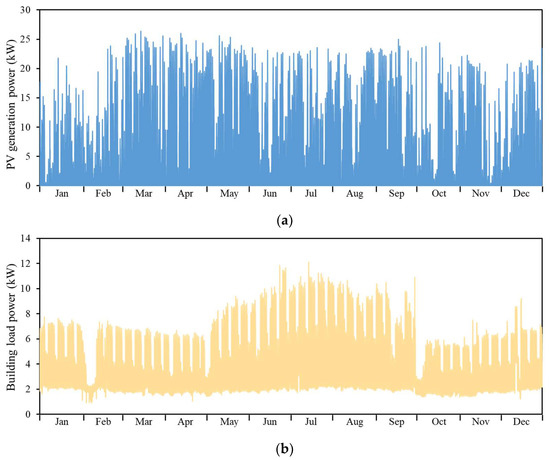
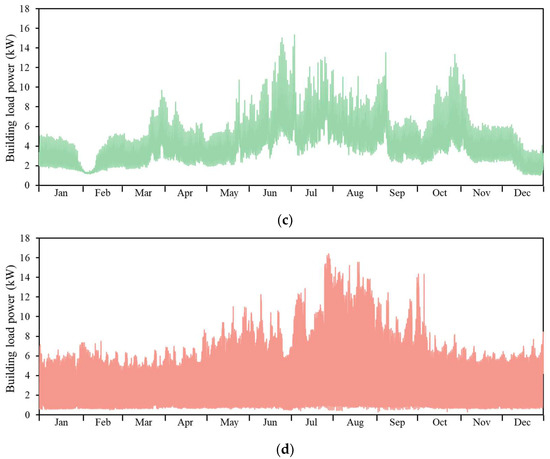
Figure A1.
Annual power data: (a) PV generation; (b) office load; (c) apartment load; (d) mall load.
References
- Chen, Q.; Kuang, Z.; Liu, X.; Zhang, T. Transforming a solar-rich county to an electricity producer: Solutions to the mismatch between demand and generation. J. Clean. Prod. 2022, 336, 130418. [Google Scholar] [CrossRef]
- Khattak, S.I.; Ahmad, M.; Khan, Z.U.; Khan, A. Exploring the impact of innovation, renewable energy consumption, and income on CO2 emissions: New evidence from the BRICS economies. Env. Sci. Pollut. Res. Int. 2020, 27, 13866–13881. [Google Scholar] [CrossRef] [PubMed]
- Jiang, Q.; Khattak, S.I.; Rahman, Z.U. Measuring the simultaneous effects of electricity consumption and production on carbon dioxide emissions (CO2e) in China: New evidence from an EKC-based assessment. Energy 2021, 229, 120616. [Google Scholar] [CrossRef]
- Ahmed Ali, K.; Ahmad, M.I.; Yusup, Y. Issues, Impacts, and Mitigations of Carbon Dioxide Emissions in the Building Sector. Sustainability 2020, 12, 7427. [Google Scholar] [CrossRef]
- Mishra, S.; Saini, G.; Saha, S.; Chauhan, A.; Kumar, A.; Maity, S. A survey on multi-criterion decision parameters, integration layout, storage technologies, sizing methodologies and control strategies for integrated renewable energy system. Sustain. Energy Technol. Assess. 2022, 52, 102246. [Google Scholar] [CrossRef]
- Yang, J.; Yang, Z.; Duan, Y. Capacity optimization and feasibility assessment of solar-wind hybrid renewable energy systems in China. J. Clean. Prod. 2022, 368, 133139. [Google Scholar] [CrossRef]
- Sharma, S.; Sengar, N. Review of solar PV training manuals and development of survey based solar PV system training formats for beginners. Sol. Energy 2022, 241, 72–84. [Google Scholar] [CrossRef]
- Qiu, T.; Wang, L.; Lu, Y.; Zhang, M.; Qin, W.; Wang, S.; Wang, L. Potential assessment of photovoltaic power generation in China. Renew. Sustain. Energy Rev. 2022, 154, 111900. [Google Scholar] [CrossRef]
- Stainsby, W.; Zimmerle, D.; Duggan, G.P. A method to estimate residential PV generation from net-metered load data and system install date. Appl. Energy 2020, 267, 114895. [Google Scholar] [CrossRef]
- Gul, E.; Baldinelli, G.; Bartocci, P.; Bianchi, F.; Domenghini, P.; Cotana, F.; Wang, J. A techno-economic analysis of a solar PV and DC battery storage system for a community energy sharing. Energy 2022, 244, 123191. [Google Scholar] [CrossRef]
- Gerber, D.L.; Vossos, V.; Feng, W.; Marnay, C.; Nordman, B.; Brown, R. A simulation-based efficiency comparison of AC and DC power distribution networks in commercial buildings. Appl. Energy. 2018, 210, 1167–1187. [Google Scholar] [CrossRef]
- Ge, J.; Shen, C.; Zhao, K.; Lv, G. Energy production features of rooftop hybrid photovoltaic–wind system and matching analysis with building energy use. Energy Convers. Manag. 2022, 258, 15485. [Google Scholar] [CrossRef]
- Zhang, K.; Prakash, A.; Paul, L.; Blum, D.; Alstone, P.; Zoellick, J.; Brown, R.; Pritoni, M. Model predictive control for demand flexibility: Real-world operation of a commercial building with photovoltaic and battery systems. Adv. Appl. Energy 2022, 7, 100099. [Google Scholar] [CrossRef]
- Bird, L.; Lew, D.; Milligan, M.; Carlini, E.M.; Estanqueiro, A.; Flynn, D.; Gomez-Lazaro, E.; Holttinen, H.; Menemenlis, N.; Orths, A.; et al. Wind and solar energy curtailment: A review of international experience. Renew. Sustain. Energy Rev. 2016, 65, 577–586. [Google Scholar] [CrossRef]
- Chaibi, Y.; Allouhi, A.; Salhi, M.; El-jouni, A. Annual performance analysis of different maximum power point tracking techniques used in photovoltaic systems. Prot. Control Mod. Power Syst. 2019, 4, 1–10. [Google Scholar] [CrossRef]
- Zhu, Y.; Xu, X.; Yan, Z.; Lu, J. Data acquisition, power forecasting and coordinated dispatch of power systems with distributed PV power generation. Electr. J. 2022, 35, 107133. [Google Scholar] [CrossRef]
- Hao, D.; Qi, L.; Tairab, A.M.; Ahmed, A.; Azam, A.; Luo, D.; Pan, Y.; Zhang, Z.; Yan, J. Solar energy harvesting technologies for PV self-powered applications: A comprehensive review. Renew. Energy 2022, 188, 678–697. [Google Scholar] [CrossRef]
- Ma, T.; Zhang, Y.; Gu, W.; Xiao, G.; Yang, H.; Wang, S. Strategy comparison and techno-economic evaluation of a grid-connected photovoltaic-battery system. Renew. Energy 2022, 197, 1049–1060. [Google Scholar] [CrossRef]
- Li, Y.; Peng, J.; Jia, H.; Zou, B.; Hao, B.; Ma, T.; Wang, X. Optimal battery schedule for grid-connected photovoltaic-battery systems of office buildings based on a dynamic programming algorithm. J. Energy Storage 2022, 50, 104557. [Google Scholar] [CrossRef]
- Chellaswamy, C.; Ganesh Babu, R.; Vanathi, A. A framework for building energy management system with residence mounted photovoltaic. Build. Simul. 2021, 14, 1031–1046. [Google Scholar] [CrossRef]
- Hesse, H.; Martins, R.; Musilek, P.; Naumann, M.; Truong, C.; Jossen, A. Economic Optimization of Component Sizing for Residential Battery Storage Systems. Energies 2017, 10, 835. [Google Scholar] [CrossRef]
- Chang, L.; Ma, C.; Zhang, Y.; Li, H.; Xiao, L. Experimental assessment of the discharge characteristics of multi-type retired lithium-ion batteries in parallel for echelon utilization. J. Energy Storage 2022, 55, 105539. [Google Scholar] [CrossRef]
- Khezri, R.; Mahmoudi, A.; Whaley, D. Optimal sizing and comparative analysis of rooftop PV and battery for grid-connected households with all-electric and gas-electricity utility. Energy 2022, 251, 123876. [Google Scholar] [CrossRef]
- Argyrou, M.C.; Marouchos, C.C.; Kalogirou, S.A.; Christodoulides, P. A novel power management algorithm for a residential grid-connected PV system with battery-supercapacitor storage for increased self-consumption and self-sufficiency. Energy Convers. Manag. 2021, 246, 114671. [Google Scholar] [CrossRef]
- Jiang, Y.; Kang, L.; Liu, Y. A unified model to optimize configuration of battery energy storage systems with multiple types of batteries. Energy 2019, 176, 552–560. [Google Scholar] [CrossRef]
- Li, J.; Zhang, Z.; Shen, B.; Gao, Z.; Ma, D.; Yue, P.; Pan, J. The capacity allocation method of photovoltaic and energy storage hybrid system considering the whole life cycle. J. Clean. Prod. 2020, 275, 122902. [Google Scholar] [CrossRef]
- Zou, B.; Peng, J.; Yin, R.; Li, H.; Li, S.; Yan, J.; Yang, H. Capacity configuration of distributed photovoltaic and battery system for office buildings considering uncertainties. Appl. Energy 2022, 319, 119243. [Google Scholar] [CrossRef]
- Li, S.; Zhang, T.; Liu, X.; Xue, Z.; Liu, X. Performance investigation of a grid-connected system integrated photovoltaic, battery storage and electric vehicles: A case study for gymnasium building. Energy Build. 2022, 270, 112255. [Google Scholar] [CrossRef]
- Mohamad, F.; Teh, J.; Lai, C.-M. Optimum allocation of battery energy storage systems for power grid enhanced with solar energy. Energy 2021, 223, 120105. [Google Scholar] [CrossRef]
- Anuradha, K.B.J.; Jayatunga, U.; Perera, H.Y.R. Loss-Voltage Sensitivity Analysis Based Battery Energy Storage Systems Allocation and Distributed Generation Capacity Upgrade. J. Energy Storage 2021, 36, 102357. [Google Scholar] [CrossRef]
- Su, D.; Lei, Z. Optimal configuration of battery energy storage system in primary frequency regulation. Energy Reports. 2021, 7, 157–162. [Google Scholar] [CrossRef]
- Kusakana, K. Optimal energy management of a grid-connected dual-tracking photovoltaic system with battery storage: Case of a microbrewery under demand response. Energy 2020, 212, 102357. [Google Scholar] [CrossRef]
- Paul Ayeng’o, S.; Axelsen, H.; Haberschusz, D.; Sauer, D.U. A model for direct-coupled PV systems with batteries depending on solar radiation, temperature and number of serial connected PV cells. Sol. Energy 2019, 183, 120–131. [Google Scholar] [CrossRef]
Disclaimer/Publisher’s Note: The statements, opinions and data contained in all publications are solely those of the individual author(s) and contributor(s) and not of MDPI and/or the editor(s). MDPI and/or the editor(s) disclaim responsibility for any injury to people or property resulting from any ideas, methods, instructions or products referred to in the content. |
© 2023 by the authors. Licensee MDPI, Basel, Switzerland. This article is an open access article distributed under the terms and conditions of the Creative Commons Attribution (CC BY) license (https://creativecommons.org/licenses/by/4.0/).